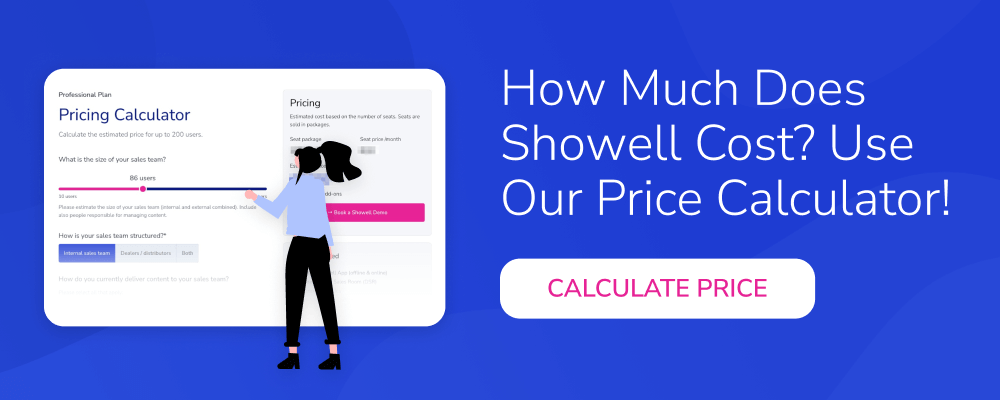As sellers, resistance and objections are typical day-to-day encounters. It is normal for customers to have concerns and ask questions, and it is the seller's job to address them.
Sales resistance is an opportunity to uncover customer needs and develop a solution. By understanding the reasons behind the resistance, you can better build trust and create more successful outcomes.
Sales enablement can play a significant role in overcoming sales resistance. It can provide sales teams with the right training, insights, and content to effectively respond to customer objections. This could involve educating the sales team about the common reasons for resistance and training them on how to navigate these objections.
It is essential to listen to resistance and objections as well as to respond with empathy and understanding. To better understand the reasoning behind these resistances let’s dive into what sales resistance is, how to interpret sales resistance, and how you can handle them in practice.
Understanding Sales Resistance and Why It Is Important
Sales resistance can be broadly defined as the opposition or hesitation prospects show during a sales conversation, making them less likely to proceed toward a purchase decision. It represents a key challenge for sales teams across all industries and can stem from a variety of factors.
But what is the difference between sales resistance and objection? Sales resistance is when a buyer expresses hesitation or opposition without explicitly stating the issue. Some questioning is needed to find the root of the resistance— which is your objection.
To better understand the difference, let’s look at the following scenarios.
Sales Resistance vs. Sales objections
Alex has delivered a detailed presentation of his software solution to TechCorp. When he asks for their thoughts, the TechCorp representative responds, "I'm not sure we're ready to make a decision yet. We'll need to discuss it internally first."
Here, TechCorp is showing sales resistance. They're not making an outright objection or providing a specific reason for not moving forward. Instead, they're indicating a hesitancy or reluctance to proceed. This resistance could be due to a variety of factors, such as needing more time to consider the proposal, a lack of decision-making authority, budget concerns, or an aversion to change.
In a follow-up meeting, Alex addresses TechCorp's resistance by asking if there are any specific concerns or questions he can address. This time, the TechCorp representative responds, "We're worried about the integration process. Our current software is deeply entrenched in our operations, and we fear the transition to a new system could be disruptive."
This is an example of a sales objection. Unlike the earlier resistance, TechCorp has now voiced a specific concern about the product— in this case, the potential disruption caused by the integration process.
In both situations, it's Alex's responsibility to handle the resistance or objection effectively. With resistance, he might need to provide more information, reassurances, or simply more time for TechCorp to make their decision. In response to an objection, Alex would need to address the specific concern raised, perhaps by providing examples of successful integrations with similar companies or offering to connect TechCorp with a customer who has had a positive transition experience.
Understanding and interpreting sales resistance is crucial for the success rate of your sales conversations. It provides invaluable insights into your prospect's mind, helping you to identify potential roadblocks in their jobs-to-be-done. Understanding the reasons behind sales resistance allows you and your sellers to devise more effective strategies to address and overcome these objections for better outcomes.
Sales Resistance: Internal Factors and Causes
Internal causes of sales resistance originate within the prospect themselves. These might include personal biases, lack of understanding about the product, fear of change, or skepticism based on past experiences. A 2009 study by Verbeke et al, "Building Adaptive Expertise and Emotional Intelligence in Sales" suggest that salespeople who have high emotional intelligence are more adaptable to customers' emotional states and can better understand and respond to their needs. This underlines the importance of having empathy and emotional intelligence from sellers in sales conversations.
Learn more about The Impact of Buyer Behavior and Cognitive Biases on Sales Performance →
Sales Resistance: External Factors and Causes
External causes, on the other hand, lie outside the influence of the individual prospect. These might include organizational policies, economic conditions, competition, or market trends. An example of an external cause is explained by this study by McKinsey showing that during the COVID-19 pandemic, many companies tightened their budgets, which caused added external resistance to sales efforts across various industries.
The Common Resistance that Sellers Face And How To Overcome Them
Sales resistance can take many forms, such as outright refusal, delays, procrastination, false promises, and lack of commitment. These reactions may often feel like obstructions, but they can also serve as a compass, helping you to understand the underlying concerns or motivations of your prospect so you can better guide them through their journey.
A study published in the Journal of Personal Selling and Sales Management highlights that the ability to understand and address different types of resistance is a key differentiator of successful salespeople. The research found that salespeople who are adept at navigating objections and resistance can increase their closing rate by 27% compared to those who struggle with these issues.

By being able to anticipate these common forms of resistance, your sellers can adapt their strategies to address the specific concerns of their prospects and improve their chances of closing a deal.
Let's explore these common types of sales resistance.
Outright Refusal
This is when a prospect directly rejects the product or service. This might sound like, "I'm not interested" or "This isn't for us." Though challenging, outright refusals often open the door for further questions to uncover the root of the resistance. For instance, is it because they don't see the value, or is it because they have had a bad past experience with a similar product or service?
💡 Solution: Overcoming outright refusal demands a blend of empathy, curiosity, and resilience from the sellers. Empathy because the refusal can often stem from a prospect's frustrations or fears, curiosity to delve into the core of the resistance, and resilience to not back away at the first sign of rejection.
When faced with an outright refusal, it's key to maintain a positive and respectful demeanor. Instead of countering immediately with a sales pitch, try to understand the root cause of their refusal by asking open-ended questions. For instance, if they say, "I'm not interested," you might ask, "Could you share more about what solutions you're currently seeking?" If they state, "This isn't for us," a follow-up could be, "Can you help me understand what you believe is missing for it to be a good fit?".
By focusing on their needs and concerns, you can steer the conversation toward how your product or service can resolve their specific challenges. But don’t be pushy! Be prepared to respect their decision if it becomes clear that your solution genuinely doesn't align with their needs.
Delays
These occur when a prospect keeps postponing a decision. They might use phrases like, "I'll think about it" or "Let's touch base in a few weeks." Delays can be a sign that the prospect is interested but not ready to commit, possibly because they need more information or because they're considering other options.
💡 Solution: When a prospect is consistently delaying a decision, it often indicates a need for further information, clarification, or assurance. It's crucial to handle such situations with patience and understanding, focusing on supporting the prospect in their decision-making process rather than pressuring them into a quick decision.
Start by probing a bit deeper with respectful, open-ended questions aimed at uncovering their concerns or uncertainties. For example, if a prospect says, "Let's touch base in a few weeks," you might respond, "Of course, I understand your need for more time. To ensure our next conversation is as productive as possible, could you share what additional information you might need, or any specific concerns you'd like us to address?".
A tactic you can use to counter "delay" resistance is to always aim to schedule time with the prospect for a follow-up call during the current meeting. This will provide a specific timeline and purpose for the next follow-up call and help to keep the conversation going. Additionally, you can also suggest an agenda for the follow-up call to make sure both parties are on the same page. For more tips on effectively preparing for sales calls, check out this guide on how to prepare for a sales call to set yourself up for success.
This approach not only shows your commitment to meeting their needs but helps ensure that the prospect is aware of the next steps and will be more likely to commit to the follow-up call.
Additionally, consider providing resources like case studies, testimonials, or white papers that might help alleviate their concerns and build trust in your solution. The key is to remain supportive and patient, fostering a relationship that prioritizes their needs and timeline.

Procrastination
Similar to delays, procrastination involves a prospect continually pushing off a decision. But, unlike delays, procrastination often lacks a clear reason or timetable. It's typically a sign that the prospect is avoiding making a decision.
Procrastination, a common form of sales resistance, may signal a deeper, unvoiced concern or objection from the prospect.
💡Solution: To address this, sellers need to employ a delicate balance of assertiveness and understanding to help prospects move past this indecision. You can encourage open communication by asking insightful questions.
Instead of simply accepting another delay, ask if there are specific factors causing their hesitation or if there is additional information they need to make a decision. Phrases like "I noticed we've had to reschedule our discussion a few times. Can you help me understand if there's a particular concern causing these delays?" can open up a conversation about what's truly holding them back.
Try and aim to add urgency without applying pressure. Show the value of your product or service by demonstrating how it solves a problem or creates an opportunity for the prospect.
A well-timed offer or incentive can also create a sense of urgency. You want them to feel comfortable and confident enough to move forward when they are ready. You can use time-limited offers to encourage prospects to take action. This could be in a form of a discount, free shipping, or a free trial period.
As an example, you can offer a 10% discount on the first year of the contract if they sign and close within a month. This gives your prospect a sense of urgency and encourages them to make a decision quickly. This tactic can gently nudge your prospect into action, reduce further negotiations, and allows you to close a deal faster.
False Promises
False promises are commitments that a prospect fails to keep. They might promise to call back or place an order but never follow through. This kind of resistance might suggest that the prospect is not fully convinced of the value of your offering, even if they express interest.
💡Solution: Overcoming this type of resistance requires a thoughtful combination of follow-up, repositioning, and relationship-building.
Begin by providing additional context to your conversations. When a prospect promises to call back or place an order, make sure you confirm their commitment. If they indicate they're still in the decision phase, consider asking, "What further information or support can I provide to help you in your decision process?" This approach shows respect for their timeline while also offering assistance.
Secondly, work on strengthening the relationship and trust factor. A starting point can be as simple as checking up on your prospect, asking how are they doing. Use follow-ups as opportunities not only to remind them of their commitment but also to build trust and deliver value. You can do so by, sharing personal anecdotes, professional milestones, or useful resources they can use to guide their decision-making. This strategy keeps the communication line open and reinforces that you care about building a lasting professional relationship with them.
Persistence is key, but it's equally important to ensure your persistence is providing value and not merely pressure!
Lack of Commitment
A lack of commitment is characterized by vague responses and noncommittal language. For example, a prospect might say, "This seems nice, but I'm not sure it's what we need right now." This might indicate that they are still exploring options and haven't yet seen the unique value your product or service provides.
When confronted with a lack of commitment from a prospect, it's essential to focus on building a stronger value proposition and establishing a deeper connection and understanding of their needs. This type of resistance often indicates that the prospect hasn't fully grasped the benefits your product or service can offer them.
💡 Solution: Aim to enhance their understanding of your solution's unique value. If the prospect is vague, it may be due to a lack of clarity about how your product or service can solve their specific problems or improve their situation.
Make sure to ask questions about their challenges and goals. Then, tailor your presentation to highlight how your solution directly addresses their needs, emphasizing its unique benefits and differentiation from competitors.
Then, take the extra mile and regularly share relevant content, industry insights, or advice that helps them in their broader business challenges, not just related to your solution. This strategy also reinforces your expertise and credibility, making them more comfortable with the idea of committing to your offering.
How To Anticipate and Prepare for Sales Resistance
Anticipating sales resistance is an invaluable skill in a salesperson's toolkit. Instead of waiting for resistance to emerge, proactive salespeople prepare for it, transforming potential obstacles into opportunities for deeper conversations and rapport-building.
- Recognize Patterns: Over time, sales professionals tend to notice common patterns of resistance among prospects. For instance, many prospects frequently express budget concerns, or those at a certain company size might often worry about implementation timescales. Recognizing these patterns allows you to preemptively address these concerns in their presentations and conversations. For example, if budget objections are common, you might include a detailed ROI analysis in their pitch, highlighting not only the cost but the value and potential return on investment. Or, if implementation concerns are frequent, they could incorporate testimonials from similar-sized clients about how the transition was smoother and quicker than they expected.
- Developing Empathy and Active Listening: Building empathy with prospects can provide insight into their needs, fears, and potential resistance. Active listening involves not just hearing what a prospect is saying but understanding the emotions and motivations behind their words. A prospect might say, "We're not ready for a change right now," which, on the surface, seems like a timing issue. However, an empathetic salesperson might hear this and understand it as a fear of change or disruption. These are the kind of insights you can only access through active listening!
- Ask Probing Questions: Don’t be afraid to dive deeper! Ask questions about their current challenges, past experiences with similar solutions, or goals they hope to achieve. The answers to these questions can provide clues about potential areas of resistance.
For instance, if a prospect had a bad experience with a previous supplier, they might be resistant to committing to a new partnership. Knowing this, a salesperson can be prepared to demonstrate how their customer service differs and how they can ensure a positive experience. - Pre-emptive Objection Handling: It's also helpful to bring up and address potential objections before the prospect does. This tactic, known as pre-emptive objection handling, not only demonstrates that you understand their concerns but also allows you to control the narrative. By addressing potential resistance proactively, you can help alleviate concerns before they become a form of objection.
|
Discovery questions play a key role in addressing sales resistance in the later stages of a deal. They bring hidden concerns to the surface and provide a clearer picture of what matters most to the prospect. By understanding their needs and hesitations, you can guide the conversation in a way that reinforces the value of your solution and builds confidence in moving forward. |
How to Handle Sales Resistance Effectively
Handling sales resistance effectively begins with a mindset shift. Instead of viewing resistance as an obstacle, see it as an opportunity to deepen your understanding of the customer's needs and build a stronger relationship. This approach requires empathy, patience, and strong communication skills.
Carew International has developed an effective method for handling resistance and objections called LAER: The Bonding Process®. It's a customer-centric communication strategy that emphasizes sellers to Listen, Acknowledge, Explore, and Respond.

Let’s build an effective approach with this method in mind:
1. Empathizing with the customer is the first crucial step. Understand that resistance usually comes from a place of concern or uncertainty about the value of your offering or the feasibility of change. It's important to practice active listening here and acknowledge these feelings. Reassure the customer that their concerns are valid.
This can be as simple as saying, "I understand your concerns about the implementation process, it's a big step and I want to assure you that we're here to support you every step of the way." Demonstrating empathy helps to build rapport and trust, making the customer more open to hearing your responses to their objections.
2. The next step is to address their objections directly and honestly. This involves first ensuring you fully understand their concerns by asking exploring and clarifying questions if needed. Once you have a clear grasp of their objection, respond with relevant information that addresses it.
For instance, if the customer is concerned about the cost, show them a detailed ROI analysis demonstrating the potential savings or revenue gains from your product or service. If they're worried about implementation, share case studies or testimonials from other customers who had a smooth transition. By directly addressing the resistance, you demonstrate your commitment to meeting the customer's needs, which can help to alleviate their concerns and move them closer to a decision.
Remember, handling sales resistance isn't about 'winning' or 'overcoming' the customer, but about working with them to find a solution that meets their needs and addresses their concerns.
In summary…
All in all, understanding the nature of these resistances and why they occur can provide valuable insights into your prospect's mindset. By recognizing and addressing each type of resistance effectively, you can alleviate your prospect's concerns and help guide them toward making a positive buying decision. It’s a win-win!
Anticipating and interpreting these sales resistance isn't about avoiding or downplaying potential sales objections, but rather preparing for and addressing them in a manner that highlights your solution's value and aligns with the prospect's needs. Taking a proactive approach can strengthen your sales conversations, build trust with prospects, and ultimately increase your chances of creating better outcomes not just for your business but also for your customer’s success.
Learn next:





